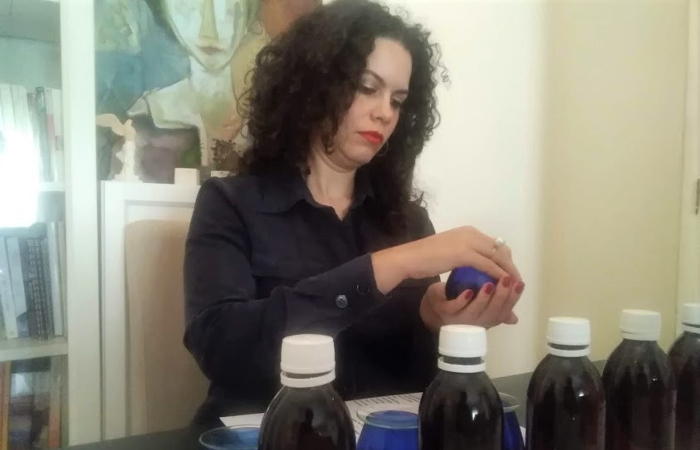By Irini Kokolaki and Lisa Radinovsky
Still not sure of the best gift to give that special person this Christmas? Looking for something that won’t sit around gathering dust? Why not try something useful, tasty, and healthy — extra virgin olive oil? To help you make the best choice, Greek olive oil expert Irini Kokolaki offers some tips.
How Do Olive Oils Differ?
The European Union and the North American Olive Oil Association classify olive oils according to one of the following designations: extra virgin, virgin, lampante virgin (not fit for consumption) or other types of refined and blended olive oils.
Olive oil classifications are based on both chemical and sensory analyses, with a sensory analysis necessary to confirm that the olive oil has no defects in flavor or aroma, regardless of its chemical analysis.
Since most consumers are unable to perform the chemical analyses which determine acidity and other characteristics, they must use their senses of taste and smell to determine olive oil’s positive or negative qualities.
To determine an olive oil’s classification before it reaches the consumer, specially trained tasters analyze it in certified laboratories which follow the regulations of the International Olive Council. This includes analysis of the oil by a group of 8 to 12 trained tasters, overseen by a panel leader.
Each group member analyzes the sample, making notes about different aspects of its aroma and flavor, and giving it a score. This result characterizes an oil as extra virgin (with fruitiness and without defects), or as virgin (virgin olive oil fit for consumption) or lampante (virgin olive oil which is not fit for consumption as it is).
Tips for Consumers — What to Look For
Actually, don’t look at all — at least, don’t worry about the olive oil’s color. Rather, smell the oil and taste it. If that’s not possible in the store, buy a small bottle of it, and try it at home.
Although the color of the oil may play a role in a consumer’s choice, its quality is actually unrelated to its color. This is why trained tasters use a blue glass which conceals the color of the oil.
To find a high quality extra virgin olive oil, seek out a predominantly “fruity” aroma. You may be able to detect an olive taste, or tastes such as apple, banana, citrus, passion fruit, or even that of fresh vegetables such as tomatoes, greens, or artichokes.
Some people can even detect the taste of freshly cut grass. A fruity aroma of some kind is expected because virgin olive oil is a natural juice, like orange juice.
Both the mouth and the nose play a role in the perception of flavor. When we taste a truly good olive oil, bitter and spicy notes may be found, perhaps along with a slightly sweeter flavor and aromas that remind us again of fruits, vegetables, grass, and spices.
These tell us that we have actual olive juice, and probably an extra virgin olive oil.
How to Taste Olive Oil
Swirl the oil around to coat the sides of a glass to release the oil’s aromas. Inhale the oil’s aroma, noticing if it is fruity. Take a sip of the oil, but don’t swallow it yet.
See if the tip of your tongue detects a slight sweetness in the oil. Hold the olive oil in your mouth while inhaling some air through your teeth. Move the olive oil around in your mouth, detecting any bitterness. Finally, swallow the oil, while trying to perceive any spiciness as it goes down your throat, and whether it makes you cough a bit.
Bitter and spicy sensations are positive attributes for an extra virgin olive oil, because they — and the cough — indicate the existence of polyphenols, which are healthy natural antioxidant and anti-inflammatory compounds.
If you are looking for an extra-healthy oil, choose an extra virgin olive oil (EVOO) which is bitter and spicy. On the other hand, many prefer fruitier EVOO’s for baking.
When an EVOO has many aromas of different fruits and/or vegetables, it is considered complex. When the fruity flavors match the intensity of the bitterness and spiciness, the EVOO is balanced.
Generally, a balanced EVOO is considered best, but when choosing for yourself, select according to your own preference. You may want to buy a variety of EVOOs to use for different purposes.
Irini Kokolaki is an expert virgin olive oil taster who has a degree from the University of Jaen in Spain. She is an olive oil competition judge, a consultant, and the Greek representative for the Spanish association “Tierra de Olivos”. She also produces extra virgin olive oil on the Greek island of Crete.
A version of this article appeared on the Greek Reporter’s associate site GreekLiquidGold.com, which provides news, information, recipes, agrotourism suggestions, and photos from the world of Greek olive oil.
See all the latest news from Greece and the world at Greekreporter.com. Contact our newsroom to report an update or send your story, photos and videos. Follow GR on Google News and subscribe here to our daily email!




